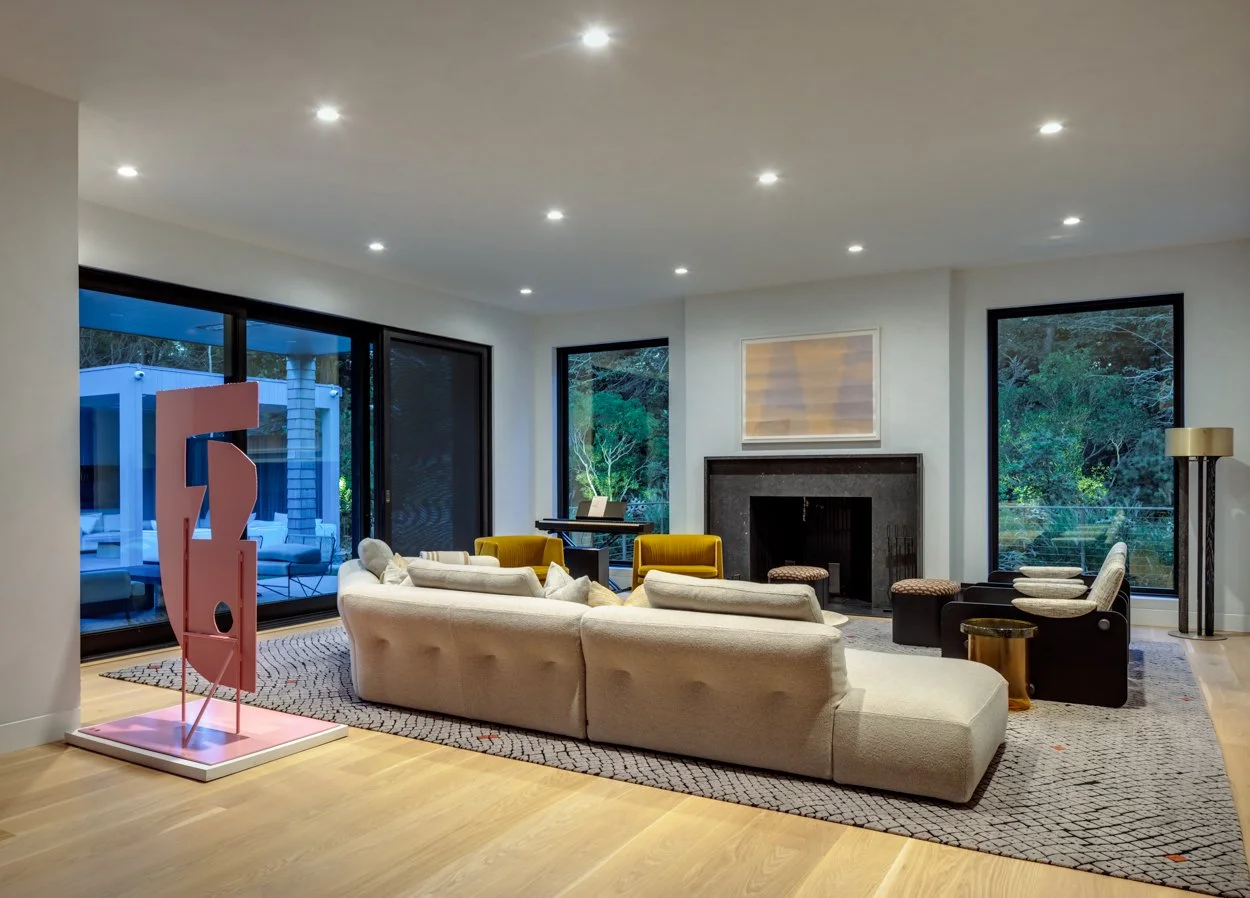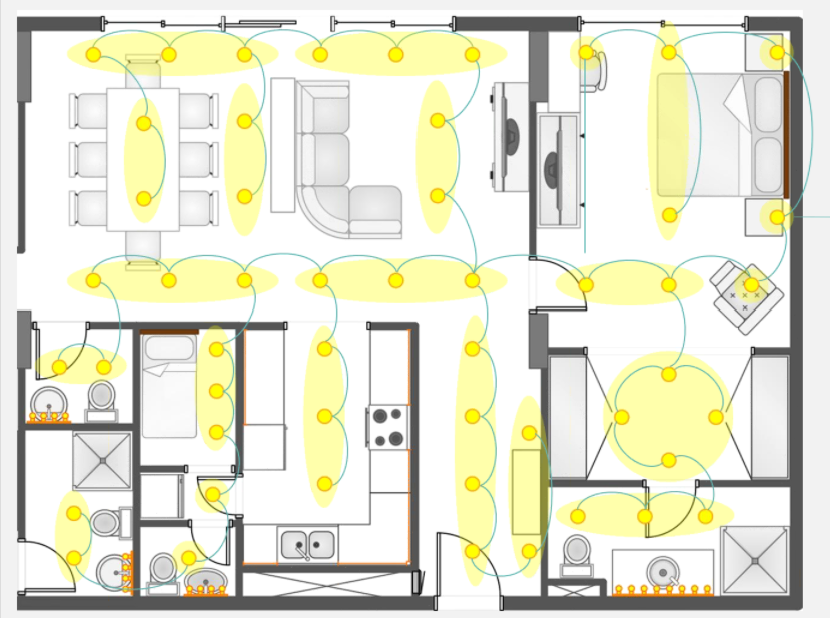
Understanding Smart Lighting Systems — A Real-World Cost Comparison
How intelligent lighting redefines design, wiring, and value
A builder recently sent us a set of plans for bid. The project called for a standard lighting layout — conventional switches, dimmers, and no lighting control system.
Although lighting controls weren’t requested, we explained that we always like to include optional pricing for them. Our goal wasn’t to push an upgrade, but to educate. We wanted the builder, designer, and electrical team to clearly see what it would cost to add smart lighting — and how those options compare to a traditional system in both design flexibility and overall value.
Rather than submitting one bid, we developed a side-by-side comparison showing how the same home could be built with or without lighting control, and with both conventional and intelligent fixtures. The result was a simple, transparent model that helped everyone involved understand their options before a single wire was pulled.
Lighting Control 101: From Switches to Smart Systems
For decades, homes have been wired the same way:
one switch per light or group of lights. It’s a system that works, but it also comes with drawbacks — walls cluttered with switches, limited flexibility in light control, and no ability to create scenes or moods without physically changing wiring.
Modern systems like Lutron RadioRA 3 and Lutron HomeWorks change that completely.
These systems replace traditional switches with elegant, programmable keypads that can control any light or group of lights in the home. They allow users to adjust scenes, automate schedules, or turn off every light in the house with a single button press.
Here’s a quick breakdown:
RadioRA 3 (RA3): A powerful wireless system ideal for small to medium homes or renovations. It allows centralized control without the need to rewire every circuit.
HomeWorks: Lutron’s flagship wired system designed for larger residences. It offers advanced scene control, integration with shading and climate systems, and a sleek, architectural-grade keypad design.
Both systems reduce wall clutter, simplify wiring, and deliver a polished, integrated experience for homeowners. Learn more here.
What Is Lumaris Intelligent Lighting?
Lutron Lumaris represents a major step forward in lighting technology. Unlike traditional downlights that simply turn on or off, Lumaris fixtures are digitally addressable — meaning they communicate directly with the control system.
Each Lumaris fixture has a small digital driver that allows it to respond to precise commands for dimming, tuning, and scene control. This makes it possible to achieve perfectly balanced light levels across a room — or even across an entire home — with fewer circuits and less wiring.
A few key advantages:
Up to 40 fixtures can be connected on a single circuit, drastically reducing wiring complexity.
No traditional dimmers are required — control happens through the processor and keypad interface.
Lighting performance becomes consistent, tunable, and precise, supporting design intent rather than limiting it.
In practical terms:
Lumaris simplifies the way lighting is installed, controlled, and experienced — giving designers and homeowners far more flexibility while helping electricians save time in the field.
Our Comparative Approach
To make the decision process easy, we modeled four clear paths for the same project:
| Option | System | Fixture Type | Description |
|---|---|---|---|
| 1️⃣ | RadioRA 3 | Conventional Fixtures | Wireless lighting control using traditional dimmers and switches. |
| 2️⃣ | RadioRA 3 | Lumaris Intelligent Fixtures | Same system, but with intelligent, digitally controlled downlights. |
| 3️⃣ | HomeWorks | Conventional Fixtures | A premium, centralized system using standard fixtures. |
| 4️⃣ | HomeWorks | Lumaris Intelligent Fixtures | The highest level of integration — intelligent fixtures paired with full home control. |
Since the original lighting plan didn’t include fixture pricing, we added a fixture allowance of $70–$100 per downlight (101 fixtures total) based on averages from comparable projects.
The Real-World Cost Comparison
| System | Fixture Type | Estimated Total | Difference vs. Conventional |
|---|---|---|---|
| RA3 | Conventional | ~$41K–$44K | Baseline |
| RA3 | Lumaris | ~$48K | +$4K–$7K |
| HomeWorks | Conventional | ~$65K–$68K | Baseline |
| HomeWorks | Lumaris | ~$66K | –$1K to +$1.7K |
The takeaway:
At the entry level (RadioRA 3), Lumaris carries a modest premium — typically between $4,000 and $7,000 more than conventional fixtures.
At the HomeWorks level, the Lumaris system becomes nearly cost-neutral or even slightly less expensive, while offering dramatically improved performance, flexibility, and visual appeal.
The Design and Wiring Advantage
Traditional lighting layouts depend on multiple dimmers and three-way switches.
Each lighting zone adds complexity, wiring, and wall clutter.
By contrast, a Lumaris-based system simplifies everything:
Redundant dimmers are replaced with hybrid keypads.
Circuits are consolidated — fewer home runs, fewer terminations.
Designers have freedom to group lights creatively without worrying about switch locations.
The result is a system that’s easier to install, easier to control, and more elegant in its finished appearance.
Key Insights from the Study
Smart lighting doesn’t always mean higher cost.
When you account for fixture value and wiring efficiency, intelligent lighting can be cost-competitive — or even more cost-effective — than conventional systems.Design flexibility improves.
Intelligent lighting removes circuit limitations, allowing lighting designers to focus on visual comfort, aesthetics, and how spaces feel.Homeowners gain convenience and simplicity.
Pre-set scenes like Entertain, Goodnight, or All Off deliver effortless control that traditional dimming simply can’t match.Builders and electricians gain predictability.
Early coordination around smart lighting reduces change orders, eliminates redundant devices, and ensures smoother installations.
Why It Matters
This study highlights an important truth:
intelligent lighting isn’t about adding complexity — it’s about removing it.
By modeling four different configurations, we showed how advanced systems like Lutron RadioRA 3 and HomeWorks can enhance a project’s design and usability without dramatically changing its cost structure. The key is education — helping everyone involved see how lighting control fits into the bigger picture of how a home functions.
Final Thoughts
At Hamptons Lighting Design and Home Technology Experts, our goal is to make lighting technology easy to understand and simple to implement.
By presenting data-driven comparisons like this, we help builders, architects, and designers make confident, informed choices about when — and how — to include smart lighting in their projects.
Smart lighting isn’t a luxury anymore — it’s the new standard of design.
And when planned thoughtfully, it can transform both the look and the livability of any home.
Home Technology Experts partners with architects, builders, and designers to deliver luxury technology solutions that respect design integrity and client expectations.
Contact us below to explore how we can support your next project with the same level of precision and collaboration.





